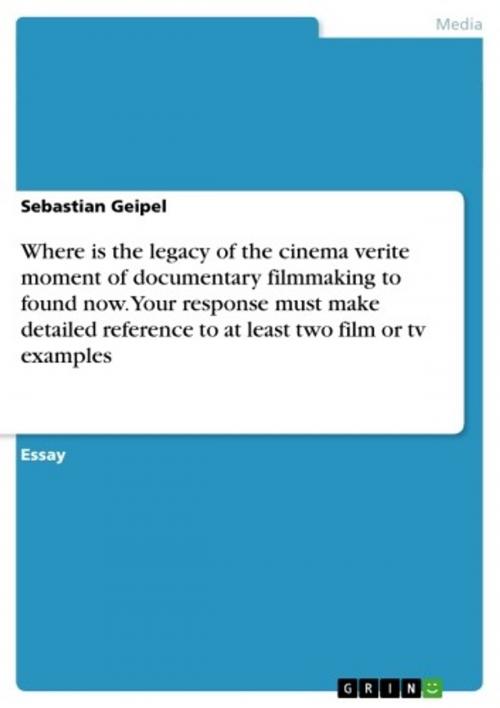Where is the legacy of the cinema verite moment of documentary filmmaking to found now. Your response must make detailed reference to at least two film or tv examples
Nonfiction, Entertainment, Performing Arts, Film| Author: | Sebastian Geipel | ISBN: | 9783638256308 |
| Publisher: | GRIN Publishing | Publication: | February 24, 2004 |
| Imprint: | GRIN Publishing | Language: | English |
| Author: | Sebastian Geipel |
| ISBN: | 9783638256308 |
| Publisher: | GRIN Publishing |
| Publication: | February 24, 2004 |
| Imprint: | GRIN Publishing |
| Language: | English |
Essay from the year 2003 in the subject Communications - Movies and Television, grade: D (1,5), Macquarie University (Media Department), course: Introduction to the Cinema, 13 entries in the bibliography, language: English, abstract: This essay will treat the 'Cinema verite' and its development until today. As the development in Europe and in the USA had been similar, I will choice to describe the German development and emphasis an example from the 60's and two from today. The movie from the 60's is the German documentary 'Warum ist Frau B. glücklich?' by Erika Runge, made in 1968, the actual examples are: 'Der 3. Weltkrieg' by Robert Stone, made in 1998, and 'Napoleon' by David Grubin, made in 2003. The stretch will lie on the first movie. It is a perfect example for the 'cinema vérité'. I will give you a short overview about the movies, explain the term authenticity and give a conclusion. And during the essay you will see differences and similarities between a motion picture and a documentary movie. You will see that today documentaries could better be called infotainment and the documentaries during the 60's could better be called portrait. While the innovation in the late 60's was, to show the normal life (before documentaries dealt with famous persons/situations), today normal and special events are shown in a mix of movie and documentary.
Essay from the year 2003 in the subject Communications - Movies and Television, grade: D (1,5), Macquarie University (Media Department), course: Introduction to the Cinema, 13 entries in the bibliography, language: English, abstract: This essay will treat the 'Cinema verite' and its development until today. As the development in Europe and in the USA had been similar, I will choice to describe the German development and emphasis an example from the 60's and two from today. The movie from the 60's is the German documentary 'Warum ist Frau B. glücklich?' by Erika Runge, made in 1968, the actual examples are: 'Der 3. Weltkrieg' by Robert Stone, made in 1998, and 'Napoleon' by David Grubin, made in 2003. The stretch will lie on the first movie. It is a perfect example for the 'cinema vérité'. I will give you a short overview about the movies, explain the term authenticity and give a conclusion. And during the essay you will see differences and similarities between a motion picture and a documentary movie. You will see that today documentaries could better be called infotainment and the documentaries during the 60's could better be called portrait. While the innovation in the late 60's was, to show the normal life (before documentaries dealt with famous persons/situations), today normal and special events are shown in a mix of movie and documentary.















